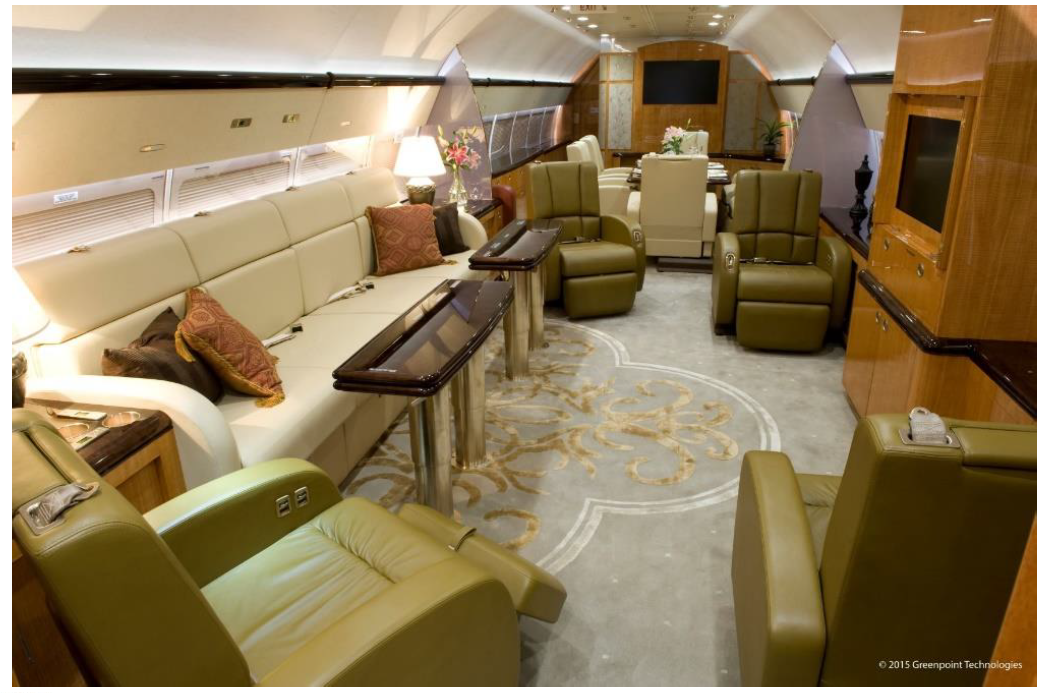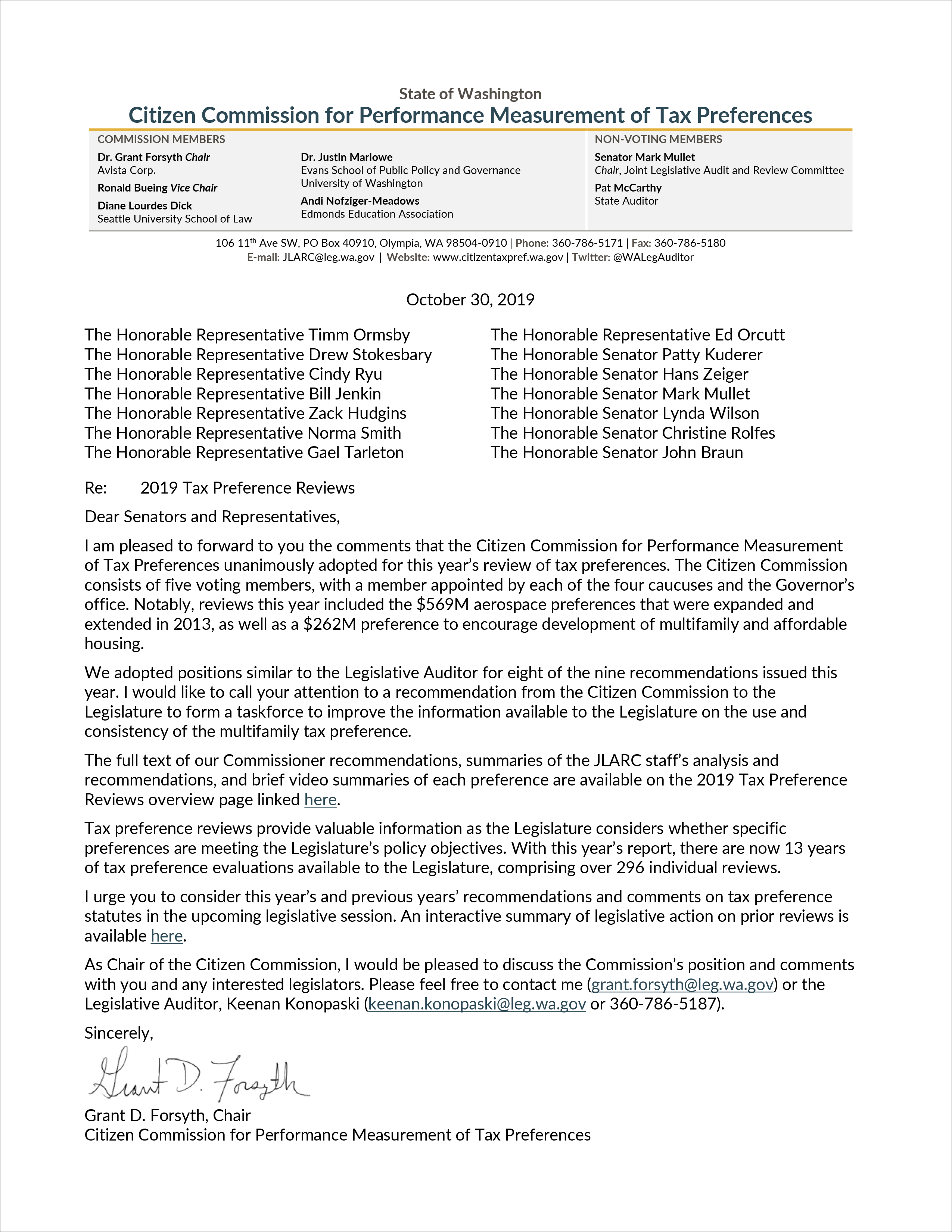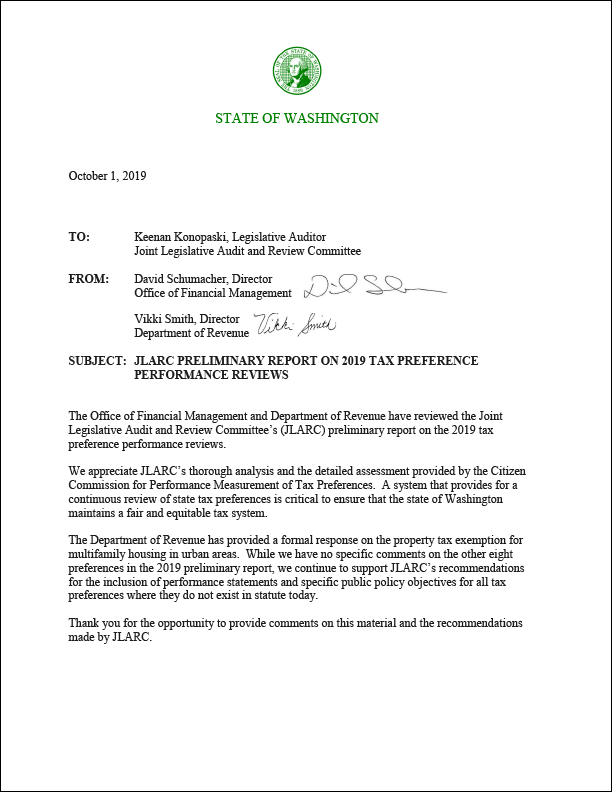JLARC staff used REMI’s Tax-PI to model two scenarios that illustrate the potential
statewide employment and tax revenue impacts if the sales and use tax preference for
large private airplanes owned by nonresidents expires in 2021.
This technical appendix provides context and supporting information for the analysis
that led to the results summarized in Tab
3.
This appendix is divided into three sections:
- REMI methodology details how JLARC staff set up and calibrated the Tax-PI
program prior to using the model to analyze possible impacts.
- Beneficiary industries describes the primary industries and businesses
currently benefiting from the sales and use tax preference for large private
airplanes owned by nonresidents.
- Scenarios modeled describes the scenarios used to estimate the range of
potential effects on statewide employment and tax revenues of the sales and use tax
preference.
REMI methodology
User inputs in REMI
REMI’s Tax-PI model allows users to model policy changes and analyze the estimated
impacts to the Washington economy, both in terms of economic activity and government
finances (see Appendix A for an overview of the REMI
model).
Prior to running modeling scenarios, users must make a series of choices about how to
set up the modeling environment by building a state budget and calibrating the model
accordingly. JLARC staff used the November 2018 revenue estimates produced by the
Economic and Revenue Forecast Council (ERFC) and budgeted expenditures for fiscal
years 2016 through 2018, as reported by the Legislative Evaluation and Accountability
Program (LEAP) Committee. This data represents the budget and revenue data in the
model and serves as the starting point for Tax-PI’s economic and fiscal forecasts.
In addition to establishing a budget and inputting expected revenue values, users
must specify whether government expenditures are determined by demand or by revenue.
- “By demand” imposes a level of government spending in future years that is
necessary to maintain the same level of service as the final year in which budget
data is entered.
- “By revenue” ties government expenditures to estimated changes in revenue
collections.
JLARC staff ran the scenarios with expenditures set to be determined by
demand. This allows users to avoid making assumptions about how policymakers may
alter spending priorities in the future. In addition, users essentially establish the
current budget allocations as carry-forward levels for each expenditure category.
Users may also elect to impose a balanced budget restriction (also known as
the balanced budget feedback loop) or leave the model unconstrained. The
balanced budget restriction forces revenue and expenditures to be equivalent and thus
may impose some limitations on economic activity. JLARC staff ran the scenarios with
the balanced budget restriction option turned on because Washington requires a
balanced budget.
Because Tax-PI is a forecasting tool, JLARC staff were unable to model the economic
and employment impacts of the tax preference beginning in 2016. Rather, JLARC staff
modeled the potential effects of changes in the qualifying activity assuming the
current tax preference expires in 2021, its current expiration date.
Data for the REMI model
The REMI model comes with historical economic and demographic data back to 2001. The
data comes from federal government agencies, such as the U.S. Census Bureau, U.S.
Energy Information Administration, the Bureau of Labor Statistics, and the Bureau of
Economic Analysis. As described above, current revenue and expenditure data for
Washington comes from ERFC and LEAP, respectively. The data to build the modeling
scenarios described below includes information provided by the two businesses
performing the majority of in-state airplane modification work.
- Changes in industry sales are based on JLARC staff estimates of beneficiary
savings, developed from Department of Revenue (DOR) tax records and information
provided by the two businesses.
- Changes in government revenue are based on JLARC staff estimates of qualifying
airplane modification work, using DOR tax records.
Beneficiary industries in REMI
The scenarios described below estimate the economic activity and tax revenue impact
using the beneficiary’s primary North American Industry Classification System (NAICS)
code, as reported to DOR. The scenic and sightseeing transportation and support
activities for transportation grouping, as recorded by REMI, combines the 487 and 488
NAICS codes into a single broad category capturing transportation support activities
in subindustries based on land, water, rail, and air. This appendix uses the term
"transportation support activities industry" to describe this broad category.
The scenarios capture the inter-industry purchases by the transportation support
activities industry. These interactions are unique to this industry and distinct from
the other 159 industry sectors in the REMI model. JLARC staff updated relevant model
inputs based on feedback from the two Washington businesses benefiting from the tax
preference.
Scenarios modeled to estimate the revenue and employment impact if the tax
preference expires
JLARC staff requested information from the two current beneficiaries, Greenpoint
Technologies, Inc. (GTI) and Aviation Technical Services, Inc. (ATS), detailing their
inter-industry supply chain purchases in Washington, current and recent annual
employment, and current salary information. The taxpayers specifically authorized
JLARC staff to use this information to evaluate the economic and employment effects of
the sales and use tax preference for large privately owned airplanes.
To illustrate the potential responses by the two current beneficiaries and the
associated revenue and employment effects, JLARC staff assumed the Legislature did not
alter or extend the current tax preference and allows it to expire in 2021. The
scenarios assume different levels of response by the beneficiaries when the preference
expires:
- Scenario 1: Assumes that current beneficiaries stop performing the airplane
modification work directly related to the tax preference, but maintain their
presence in Washington. They continue to perform work unrelated to the tax
preference. JLARC staff modeled this potential response by removing an amount of
industry output equivalent to the estimated qualifying modification activity.
- Scenario 2: Assumes one of the two current beneficiaries, GTI, moves their
entire operation out of Washington while the other beneficiary, ATS, remains in
Washington, but no longer performs the airplane modification work. JLARC staff
modeled these potential responses by reducing the aggregate sales for the
transportation support activities industry by an amount equal to GTI’s estimated
statewide business activity and ATS’s estimated qualifying modification activity.
The results below focus on the two areas the Legislature identified as the primary
public policy objectives for this preference: the estimated impact to economic
development in Washington's aerospace cluster and state tax revenues. For this report,
JLARC staff defined the aerospace cluster as the aerospace parts and products
manufacturing industry (NAICS 3364), also referred to as the "aerospace manufacturing
industry." The results also describe the estimated impact on statewide employment if
the preference expires.
Model forecasts future impacts
The REMI model is a forecasting tool. It cannot be used to model the effects from the
tax preference beginning in 2016. According to REMI, the change in economic activity
and reduction in government revenues from the preference are captured in the
underlying model data and the budget updates entered by JLARC staff.
The modeling approach assumes the current tax preference expires July 1, 2021. The
potential responses from industries and businesses to this policy change are estimates
beginning at the start of the 2021-2023 biennium.
Scenario 1: Businesses cease qualifying airplane modification work, but maintain
other operations in Washington
To model this scenario, JLARC staff assume the following:
- Changes in sales at the industry level begin the first day of fiscal year 2022
(July 1, 2021) when the current tax preference expires.
- Both businesses maintain their presence in Washington and sales decrease by the
sum of the estimate of all instate activity for both businesses.
- The values entered into the model grow 2% per year, consistent with the REMI
model's estimated average output growth by the transportation support activities
industry through 2031.
JLARC staff also worked with REMI staff to correct one of the built-in revenue
assumptions of the model. The model assumes that a decrease in industry sales is
associated with a decrease in sales tax and a decrease in state revenues. However,
airplane modification work was not taking place in Washington before the tax
preference was enacted, and both businesses indicated that the work would very likely
be moved out of state if the tax preference expires. To address this, JLARC staff
included a positive revenue shock to offset the default assumptions of the model.
The estimated change in industry sales are shown below ($ in millions):
|
2021 |
2022 |
2023 |
2024 |
2025 |
2026 |
2027 |
2028 |
2029 |
2030 |
2031 |
| Estimated change in Industry Sales ($millions) |
-31.1 |
-62.2 |
-63.5 |
-64.7 |
-66.0 |
-67.3 |
-68.7 |
-70.1 |
-71.5 |
-72.9 |
-74.3 |
Note: 2021 represents the last six months of the calendar year after the preference
expires.
Source: JLARC staff analysis of DOR tax return data.
Results: No change in aerospace manufacturing industry jobs. Tax revenues expected
to decrease by an average of $1.8 million per year and employment by an average of 347
jobs per year between 2022-2031.
No change in aerospace industry jobs. The estimates for this scenario indicate
that employment in the aerospace parts and products manufacturing industry (NAICS
3364) is not significantly impacted by the possible loss of business activity related
to the tax preference. Specifically, REMI estimates that the employment change in the
aerospace manufacturing industry will be flat, with no additional jobs lost between
2022 and 2031.
Statewide tax revenues decrease by $1.8 million per year on average. Under the
assumptions of this scenario, aggregate statewide tax revenues are expected to
decrease by $1.8 million, on average, between 2022 and 2031, relative to the baseline
estimate. The revenue estimate captures the tax impact associated with decreases in
all induced and indirect economic activity.
Statewide employment decreases by 347 jobs per year on average. Statewide
employment is estimated to decrease by 347 jobs, on average, between 2022 and 2031.
Losses peak at 404 jobs in 2023 followed by small rebounds in employment in subsequent
years.
Scenario 2: Qualifying airplane modification work ceases and one business relocates
out of Washington
To model this scenario, JLARC staff made the same
assumptions described under scenario 1 except for estimated sales. Under this
scenario, the assumption is that sales decrease by the sum of the estimated value of
all instate activity for one business and the estimated value of the qualifying
airplane modification activity for the other business. The former captures the
possible relocation of the business outside of Washington.
The estimated change in industry sales are shown below ($ in millions):
|
2021 |
2022 |
2023 |
2024 |
2025 |
2026 |
2027 |
2028 |
2029 |
2030 |
2031 |
| Estimated change in Industry Sales ($millions) |
-42.7 |
-87.1 |
-88.8 |
-90.6 |
-92.4 |
-94.2 |
-96.1 |
-98.1 |
-100 |
-101 |
-104 |
Note: 2021 represents the last six months of the calendar year after the preference
expires.
Source: JLARC staff analysis of DOR tax return data.
Results: No change in aerospace manufacturing industry jobs. Tax revenues expected
to decrease by an average of $3.3 million per year and employment by an average of 569
jobs per year between 2022-2031.
No change in aerospace industry jobs. The estimates for this scenario indicate
that employment in the aerospace parts and products manufacturing sector (NAICS 3364)
is not significantly impacted by the possible loss of business activity related to the
tax preference. Specifically, REMI estimates that the employment change in the
aerospace manufacturing industry will be flat, with no additional jobs lost between
2022 and 2031.
Statewide tax revenues decrease by $3.3 million per year on average. Under the
assumptions of this scenario, aggregate statewide tax revenues are expected to
decrease by $3.3 million, on average, between 2022 and 2031, relative to the baseline
estimate. The revenue estimate captures the impact of lost indirect and induced
economic activity related to the likely loss of qualifying large airplane modification
work.
Statewide employment decreases by 569 jobs per year on average. Statewide
employment is estimated to decrease by 569 jobs, on average, between 2022 and 2031.
Losses peak at 665 jobs in 2023 followed by modest employment rebounds in subsequent
years.
❮ Previous
Next ❯






